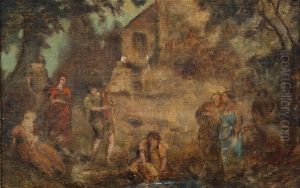Yrjo Ramstedt Paintings
Yrjö Alfred Ramstedt, born on April 7, 1888, in Helsinki, Finland, was a lesser-known artist in the broader scope of European art history, yet he held significance within the Finnish art community of his time. His artistic journey began in a period of national awakening, with Finland striving for cultural identity and independence from Russia, which was achieved in 1917.
Ramstedt's early life was influenced by the Art Nouveau movement, which was prominent across Europe, including in Finland where it became known as Jugend. He studied at the Central School of Arts and Crafts in Helsinki and later continued his studies abroad. His exposure to various European art centers, including Paris, which was a hub for artists from all over the world, allowed him to delve into different styles and techniques.
Upon returning to Finland, Ramstedt found himself immersed in a thriving art scene, contributing to the burgeoning Finnish identity through his work. His style may have been influenced by the likes of Akseli Gallen-Kallela and other Finnish artists who sought to capture the essence of the Finnish landscape and mythology in their art.
During his lifetime, Ramstedt exhibited his work in various galleries and was involved in the artistic community, participating in cultural events and organizations. His body of work encompassed a range of subjects, including landscapes, portraits, and perhaps scenes of everyday life, rendered in a style that reflected the evolving trends of his time, from Art Nouveau to later movements.
Yrjö Ramstedt passed away on March 15, 1952. While he may not have gained the international acclaim of some of his contemporaries, his contribution to Finnish art during a pivotal period of its development was significant. His legacy remains as part of the narrative of Finnish art history, a testament to the rich tapestry of local talent that contributed to the country's cultural heritage.
